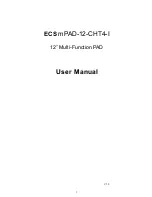
45
Background
The IDM01 can generate timing signals to which other devices can synchronize if:
• The external device (sequencer, drum machine, etc.) can respond to MIDI timing signals.
• These signals go from the IDM01's MIDI out to the external device's MIDI in.
•
CLOCKOUT
is
ON
.
When slaving the IDM01 to other devices,
CLOCKOUT
should be
OFF
and
CLOCK IN
should be
ON
.
6.7 PAGE 7: MERGE MIDI IN WITH MIDI OUT (MIDITHRU)
MIDITHRU
PAGE
OFF
SETUPMIDI
PERFORM
The display shows
MIDITHRU
. To have the IDM01 merge data appearing at the MIDI in with
the timing and/or note data appearing at the MIDI out, use the INC/DEC buttons to select
ON
.
Select
OFF
to have the IDM01 MIDI out carry IDM01 timing and note data only.
Background
Turning MIDI out to MIDI thru can be handy for some system applications.
Example:
Assume a
MIDI keyboard connects to the IDM01 MIDI in. The IDM01 serves as the master clock for an MMT-8 sequencer;
the IDM01 MIDI out connnects to the MMT-8 MIDI in. With
MIDITHRU
set to
ON
, the keyboard note data will be
passed through the IDM01 and appear at the MMT-8 MIDI in.
Other IDM01 settings should be
DRUM IN OFF
(so the IDM01 doesn't respond to your keyboard playing) and
CLOCKOUT
ON
so that the IDM01 clock drives the MMT-8.
DRUMOUT
should also be
OFF
so that the MMT-8
doesn't record the IDM01 drum notes. Plugging the MMT-8 MIDI out to the keyboard MIDI in plays back the
sequenced notes through the keyboard.
Technically speaking, MIDI timing data (as provided by a master unit such as a sequencer) received at the
IDM01's MIDI in is not sent to the MIDI out. However, this will appear to be the case since the IDM01 will
generate its own timing data in response to the timing data received at its MIDI in, if
CLOCK IN
and
CLOCK OUT
are both
ON
.




































